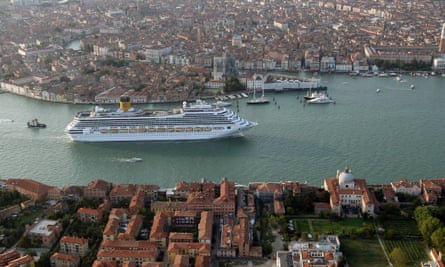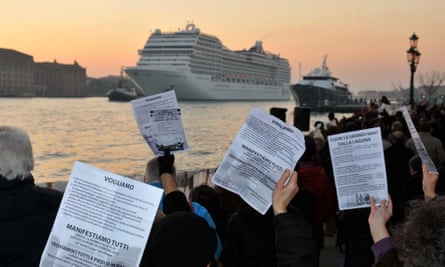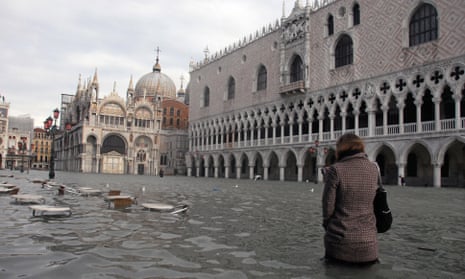Every winter, it seems, we see pictures in the press and on TV of St Mark’s Square looking like a lake. People wading through thigh-high water. Boats bobbing outside the famous cafes. Venice is sinking rapidly, these images imply.
The pictures are misleading, however. St Mark’s Square does indeed get flooded, dozens of times every year, but in all except the worst floods more than 90% of the rest of the city remains above water. And though many buildings in Venice are subsiding, the city as a whole isn’t sinking – rather, parts of it are becoming submerged.
The major floods are destructive, of course. Whenever water breaks through the stone damp-courses that protect most Venetian buildings, it seeps into the porous brickwork. All over Venice, walls are dissolving. And if, with global warming, sea levels rise as they are projected to, the situation is going to get a lot worse. Having an average depth of little over one metre, the Venetian lagoon is particularly vulnerable to the vagaries of the climate.
Which is why the construction of a movable barrier across the entrances to the lagoon seems to many people the obvious way of averting calamity. Mose, as Venice’s flood barrier is known, consists of 80 huge steel flaps that lie on the bed of the lagoon, forming a submerged barrage that will be raised whenever the water rises dangerously. It might appear to be an obvious solution to the crisis. Yet Mose is a project that makes many Venetians despair, for various reasons.

For one thing, it’s way behind schedule. Work began in 2003, more than 20 years after the scheme was submitted to central government, and is still incomplete. Corruption, inevitably, is partly to blame. Many opponents of Mose alleged from the start that the scheme would be a gigantic palm-greasing exercise, and so it has proved. In 2014, Giorgio Orsoni, the incumbent mayor of Venice, was arrested in connection with investigations into the funding of the barrier. It appears that as much as €1bn has gone astray in a labyrinth of shady deals. We are now told that Mose will finally be functional next year.
Many locals are not so sure. In 2014, the Nuova Venezia newspaper published photos that showed that the steel flaps had already suffered more corrosion than the builders had anticipated. In August this year, a test-run of the floodgates was a fiasco. But let’s assume that, eventually, Mose will work as intended. Will it be Venice’s salvation? To answer that question, we need to look at why the water spills into the city’s streets so often.
The acqua alta, as the seasonal flooding is known, is caused by a combination of high tides, fluctuations in atmospheric pressure and southeasterly winds. It’s always been a feature of Venetian life. But the frequency and severity of flooding has increased markedly since the middle of the 20th century. Between 2000 and 2013 there were eight highest-category floods recorded – more than in the preceding 50 years. This phenomenon is not explained by subsidence or any rise in sea level. It’s the result of changes in the way the lagoon has been managed.
One factor has been the reclamation of large areas of land, for Marco Polo airport and the industrial sites of Marghera, and in central Venice itself – notably around the docks and the Tronchetto car parks. The marshes and mudflats of the lagoon play a crucial role in dissipating the energy of the incoming water, so their reduction has led to an increase in the destructiveness of the tides. Even worse has been the impact of shipping. When the refineries and factories of Marghera were developed in the interwar years, deep channels were carved out of the lagoon bed to allow tankers to get into the port. The result: too much sea water gets into the lagoon, and it’s moving too quickly.

All over the city, foundations are being scoured out by the quick-flowing tides. And disruption of the lagoon’s long-established equilibrium has resulted in an increase in the number of extremely low tides as well as the number of floods. Most buildings in Venice are built on wooden pilings driven deep into the mudbanks. They’ll last for centuries as long as they stay underwater, but now the water level sometimes drops so far that air gets at the pilings, causing them to rot.
And there’s another source of erosion. In the past two decades, the volume of motor-powered traffic on Venice’s canals has doubled. The foundations of more than 60% of the buildings on the Grand Canal have been damaged by the wash from the waterbuses and barges, and the situation has worsened since Venice became one of the Mediterranean’s biggest ports for cruise ships. These monstrous vessels – most of which plough right through the Giudecca canal, past the Doge’s Palace, on their way to the docks – are the most contentious issue in the city at the moment. So far, there has been no serious assessment of the damage they are causing, though it’s known that the turbulence the ships create goes on for hours after they have passed.
In 2015 the biggest ships were banned from the Giudecca canal. This was widely hailed as good news, but there was an under-reported catch: the ruling applied only to vessels of more than 95,000 tonnes. To put this in perspective, the Titanic was nowhere near that size. And the ban was soon overturned anyway. Depressingly, Luigi Brugnaro, the businessman who became Venice’s mayor in June 2015, does not see much of a problem here. He’s in favour of a scheme that will divert the mega-cruisers to the docks via the southern lagoon. This would entail large-scale redredging that critics say will damage the ecosystem even more than the cruise ships do at the moment.

So it seems that the mega-cruisers will continue to bring in tens of thousands of people who spend very little time – or cash – in the city itself. Which brings us to the other issue that’s giving rise to increasingly vehement protests in Venice: mass tourism. The population of central Venice and the lagoon islands has now dropped below 55,000. The number of visitors, annually, is approaching 7 million. Around half of those don’t even stay for one night, and thus contribute almost nothing to the local economy.
Venice’s financial situation is dire: the town hall has a shortfall of tens of millions of euros in its operating budget, and its debts exceed €400m. In effect, the place is bankrupt. And with nearly all of Venice’s special funding for maintenance of the historic centre having been diverted into the money pit of the flood barrier, much of the city’s fabric is in need of urgent repair.
That said, the churches and palazzi should continue to stand for many more decades. Long before the water overwhelms Venice, however, it could die of tourism. As short-stay rentals push the cost of living in Venice higher with every passing year, the native population is being driven out. Venice is becoming a ghost-city, a high-culture holiday resort. It’s in that sense that it’s really sinking – and fast.
